Once upon a time, the hills and mountains of the Calabrian Serre were abuzz with an activity that today may be characterized as a form of industrial archeology, an out-of-doors cottage industry of carbon production. Woodsmen practiced the artisanal craft for millennia. In our times, the labor-intensive process is almost extinct. However, in Calabria, a handful of men still carry forth the tradition, transforming trees to charcoal in a mountainous zone between the Tyrrhenian and Ionian Seas. They are called carbonai, charcoal makers or charcoal burners, and their work is fascinating.
WHERE DOES CHARCOAL COME FROM?
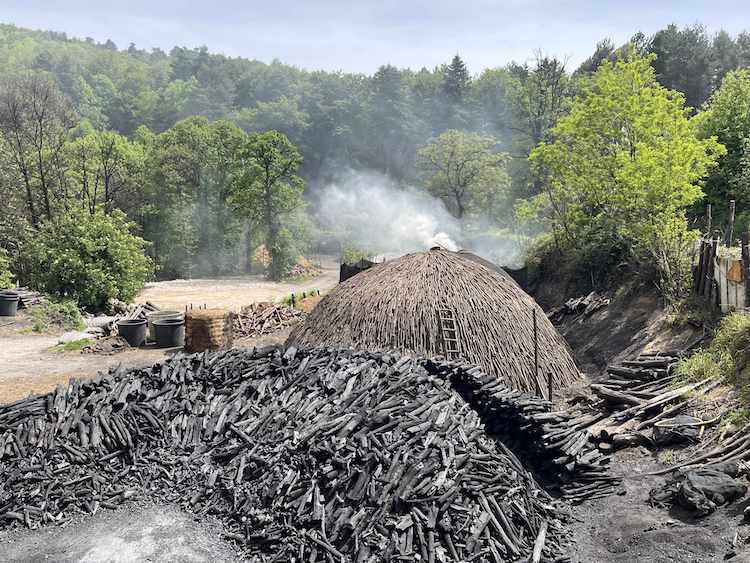
Various stages of the process of burning wood to obtain charcoal
When I first came across the process of making charcoal, I thought I had misunderstood, as I was reading an Italian novel in its original language. Tough mountain men cut trees, stacked the logs in a particular way, covered them and then slowly burned the structure in a controlled manner to obtain charcoal. The operation seemed grueling and if done incorrectly resulted in the waste of a month’s labor as well as of the precious resources, which would be the ruin of the carbonaio or charcoal burner.
As they say, it’s a dirty job, but somebody’s gotta do it.
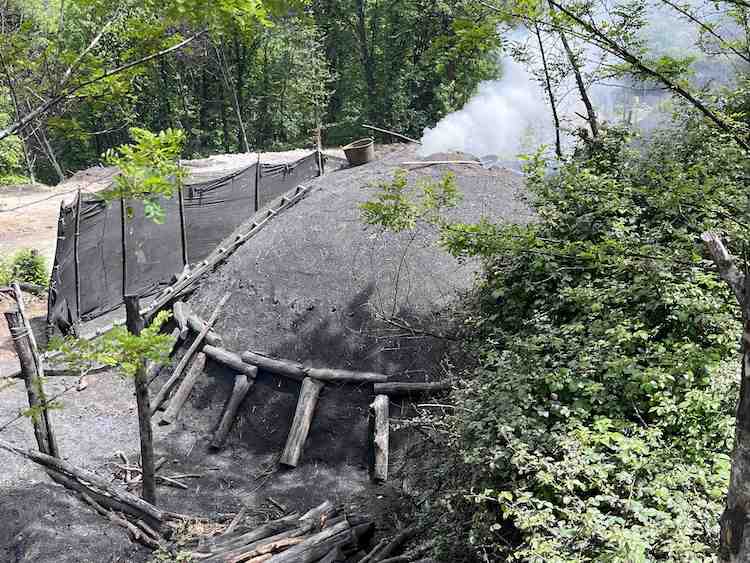
Traditional method of making charcoal
The end product of this controlled combustion process is a material that burns hotter and longer than the slowly heated firewood itself. Historically, charcoal was used as a fuel source for heating, cooking, metalworking, etc.
CARBONAI – CHARCOAL BURNERS IN SERRA SAN BRUNO
At the end of a rough road that you wouldn’t want to traverse in your own vehicle, not too far from the center of Serra San Bruno in the Serre calabresi, the aforementioned forest-rich mountain chain, I witnessed this traditional mestiere, craft or perhaps vocation, in action for myself. I use the word vocation, as the men doing this work were dedicated to the task.
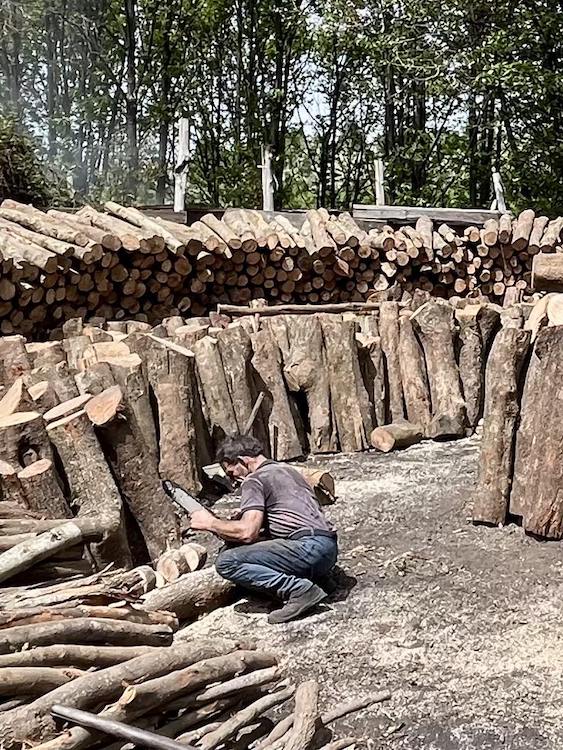
Carbonaio building the wooden structure to be burned
These carbonai are generation upon generation of carbon burners. Not only is the work physically demanding with considerable strength and stamina required, but to obtain a positive result, the carbonaio must have construction skills, be attentive to detail, and devote an inordinate amount of time to monitor the mounds, hours and hours above and beyond. But as I said, these men are devoted to their work, and as Dickensian as they may look to a city dweller, covered from head to toe in soot, they live in the here and now with cell phones in their pockets and freshly laundered garments at the ready to step out in the piazza.
THE ANCIENT CHARCOAL PROCESS
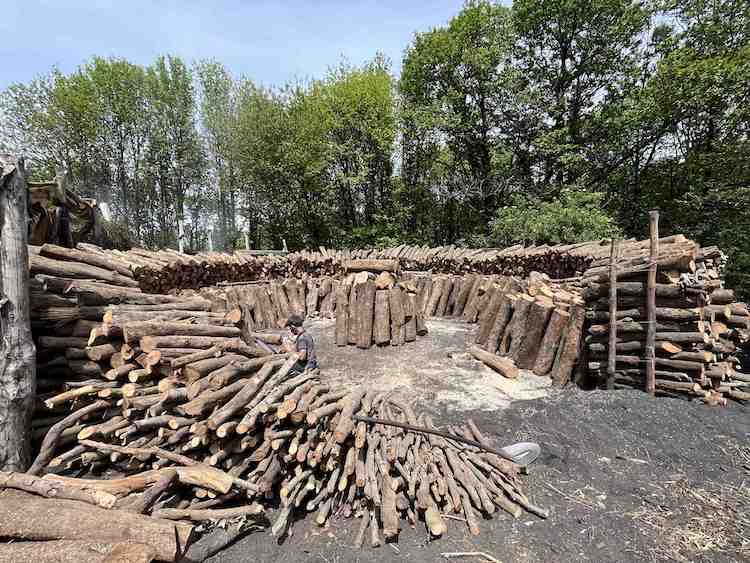
Amidst the process of stacking the wood
In the area of the Serre Mountains, just a few charcoal-burning sites remain, family owned and operated. The process requires approximately thirty days with the wood coming from local forests. The first ten days are spent building the dome-shaped structure. The geometric stacking of the wood with larger pieces in the center and the thinnest branches perfectly lined up around the outside is impressive to see.
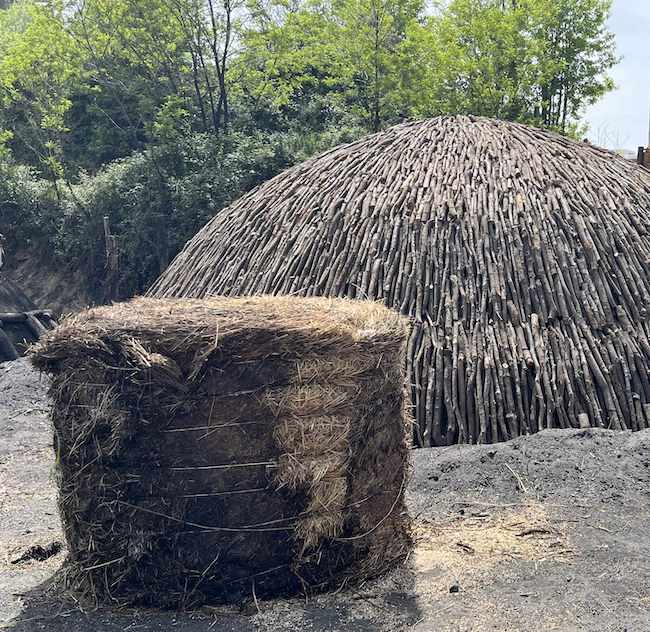
Bale of hay ready to be placed over outer layer of smaller logs
With its circular base, the construction resembles an ancient dwelling, the center of which can rise over six meters (twenty feet) so a handmade ladder is rigged up to reach the top. The carbonai take exacting care in building what they call the scarazzo.
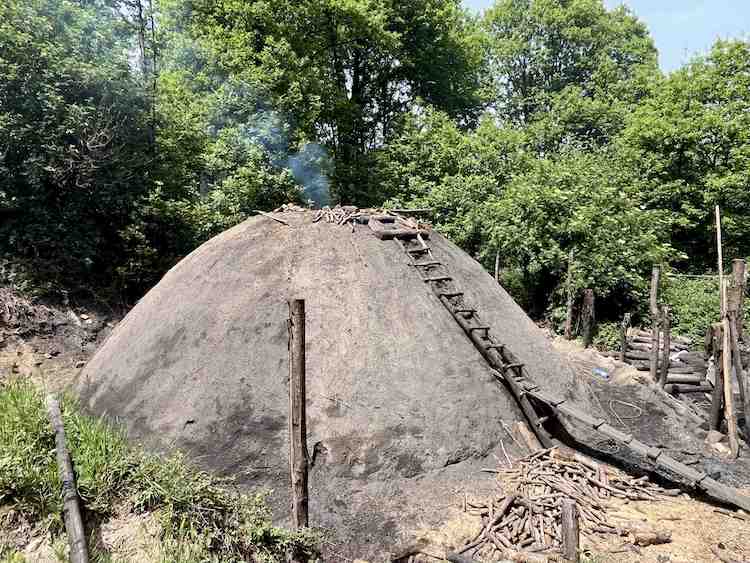
The carbon burner’s “scarazzo” with ladder to reach the top
The structure is covered with a layer of wet straw and then earth, essentially creating a sort of kiln. Lit from the center, the procedure is to ignite a smoldering fire that distributes the heat evenly due to the layout of the logs. The amount of oxygen is limited so the logs don’t flame. The carbonai must have patience, especially during the combustion period. The inner smolder must be checked and replenished with wood. They also put holes in the sides of the dome to allow the smoke or vapor to escape. The goal is to vaporize moisture and other gases from the wood, with the end result being a black carbon material – the charcoal.
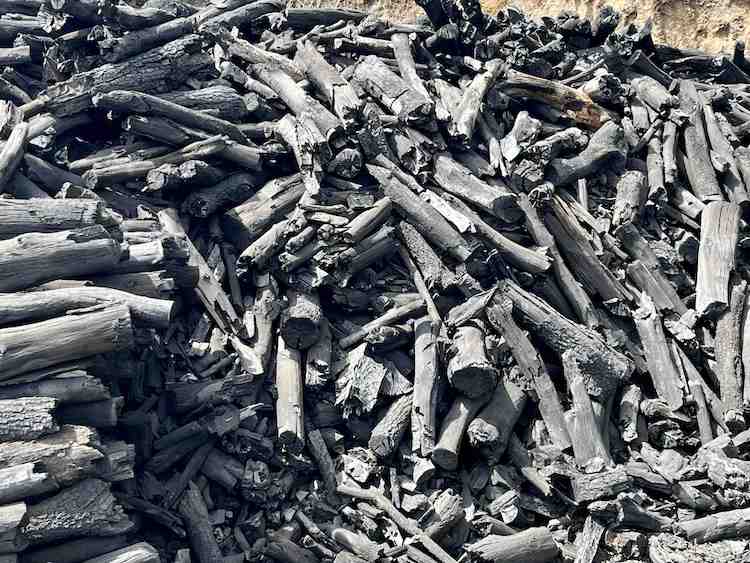
Charcoal produced using traditional methods in Serra San Bruno
TRADITIONAL, PLANT-BASED CHARCOAL FOR THE BARBECUE
The aromas of the wood vary, depending on whether they’re burning holm oak or beech, for instance. The color of the smoke tells the charcoal burner when the charcoal is ready. Water is thrown on the dome and the outer crust is broken, revealing a multitude of log-shaped pieces of charcoal, ready to be inserted into jute bags and hauled off to their destinations.
Breathing the air at the site felt like being at a barbeque festival on steroids. And you of course bring the aroma away with you. I’ve been told that the smoke isn’t toxic. Rather, it’s vapor from the burning of organic substances. I found it curious that several of the carbonai were smoking. I asked one why he felt the need to smoke a cigarette with all the vapors already surrounding him? He gave a little laugh.
Seeing the carbonai working diligently is like a window on another world, another time. There were small, handheld chainsaws to cut the logs, but merely ordinary shovels to throw and spread the earth over the structure. You see it and you still can’t believe it.
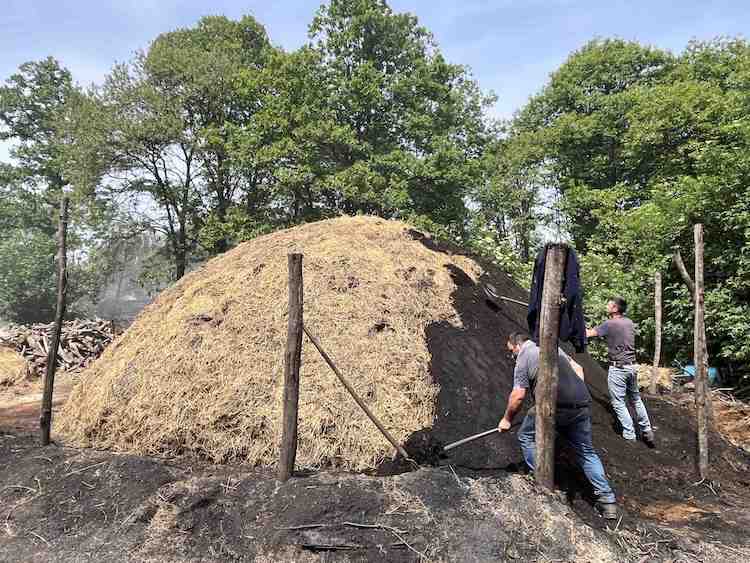
Charcoal burners using shovels to cover the straw with dirt
The product is truly artisanal and can be used indoors and out. It’s the opposite of the awful smelling briquettes that fill suburban air in the summertime. This plant-based charcoal is the best in the world, and anyone would be lucky to have this top-quality product from Calabria fueling their grill.
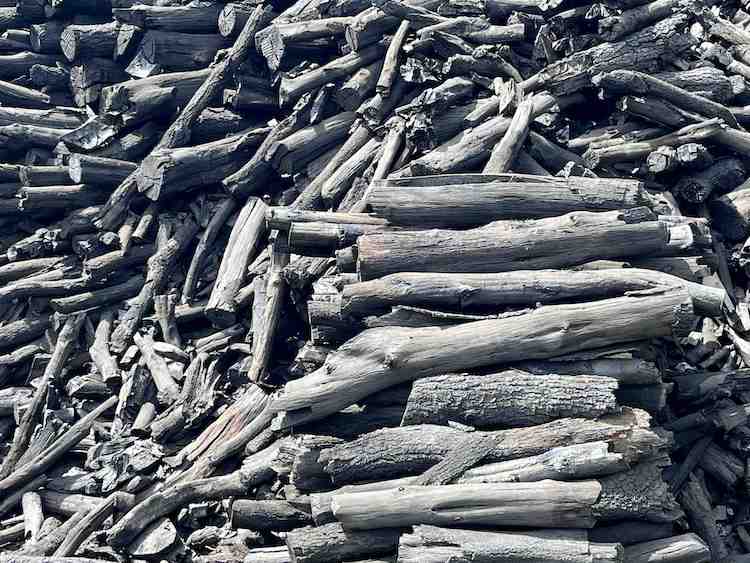
Plant-based charcoal
Calabria is known for its outstanding food, and yes, they grill! Join me on one of my small-group Calabria Tours (I have three itineraries) or on my Basilicata Tour of Calabria’s northern neighbor.
Read about the fascinating Calabrian region in my book Calabria: The Other Italy, described by Publisher’s Weekly as “an intoxicating blend of humor, joy, and reverence for this area in Italy’s deep south,” and explore Calabria’s northern neighbor in my book Basilicata: Authentic Italy, “recommended to readers who appreciate all things Italian” by the Library Journal.
Follow me on social media: Basilicata Facebook page, Calabria: The Other Italy’s Facebook page, Karen’s Instagram and Karen’s Twitter for beautiful pictures and information.
Sign up below to receive the next blog post directly to your email for free.

Comments 8
love this!!! the story of my family!!!! my name!!!! thank you Karen, eloise carbone
Ah Si, anche io. My name Carbone too. My immigrant great uncles came to the US, to the West, and became coal miners in Wyoming, so they carried our surname to the occupation in the New World.
Author
Wow, a reunion of the Carbone families of Calabria! Glad you enjoyed my blogpost.
A fascinating read, I loved every detail.
Do the carbonai currently face any threats such as not having an ample amount of young people (or interested young people) to carry out the family business, or becoming obsolete due to higher cost of living, globalization, etc.?
Author
I’m pleased you liked my post, Matt. Yes, as you can see, this is grueling work, and since it has been passed down through families, fewer young Italians are willing to do it. Methods of this type were developed in other places, as well, but have generally died out in favor of other energy sources or of large-scale industrial procedures that loosely model the practice in a commercial setting with lower-quality results. I don’t know what the future will hold, whether they’ll train workers from poorer countries to do the work, for example, or if they’ll one day close up shop…
Interesting how the carbonai have still managed to hold on while others haven’t. Goes without saying that it’d be a massive shame if they were to extinct. Thanks for the insight.
As always, a great post Karen! Even making charcoal is an artisanal technique-it is amazing that they still do it. I always thought of carbonai as coal miners, but charcoal producers makes sense.
I had them on my mind just yesterday while editing an article I am working on about the history behind the 4 iconic Roman pasta dishes. Carbonai in Lazio are the originally creators of Pasta Carbonara-or i guess their wives were. They added eggs to Pasta alla Gricia for added protein and brought it to work with them. I will have to clarify if they were coal miners or charcoal makers! Ciao, Cristina
Author
I was originally confused by the word, myself, as I said, because I wasn’t aware of this method of producing charcoal. Then upon reflection, a coal miner would be a minatore di carbone, as they work in a mine. As for pasta alla carbonara, I had thought about mentioning it in the post, but there are so many versions as to its origins that I thought it could be a blogpost in itself! In any case, for the carbonai theory, it would be referencing the charcoal burners in the Apennines, and it would have been the workers themselves as they would have been sleeping under the stars for extended periods of time, monitoring their smoldering wood pile.